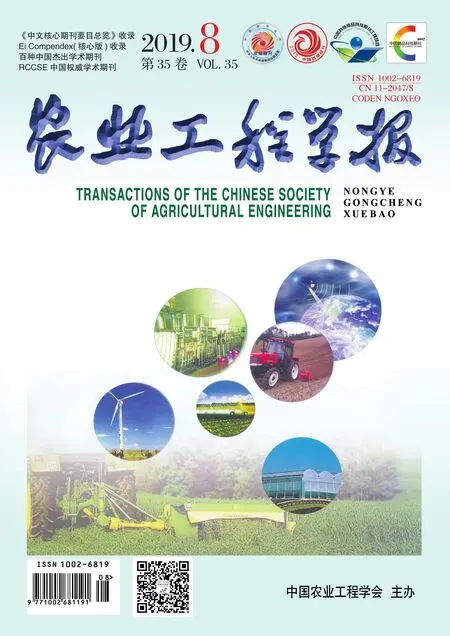综合形态与叶片叶绿素含量的番茄壮苗指数筛选
2019-05-24宫彬彬章铁军吴晓蕾吕桂云褚新培高洪波
宫彬彬,王 宁,章铁军,吴晓蕾,吕桂云,褚新培,高洪波※
综合形态与叶片叶绿素含量的番茄壮苗指数筛选
宫彬彬1,王 宁1,章铁军2,吴晓蕾1,吕桂云1,褚新培1,高洪波1※
(1. 河北农业大学园艺学院,保定 071001;2. 河北农业大学现代教育技术中心,保定 071001)
为建立最佳的番茄秧苗壮苗指数,提高秧苗评判的准确度,该文以四叶一心番茄秧苗为研究对象,在测定11项秧苗指标的基础上,利用模糊综合评判法建立番茄秧苗综合评价指数,使用主成分分析进行指标筛选并组合构成多个番茄壮苗指数,通过综合评价指数与壮苗指数的相关分析筛选出适宜的壮苗指数并验证。结果表明:对300株样本进行统计分析,番茄秧苗综合评价指数为0.26~0.79,可全面概括秧苗的整体素质,能客观、准确地评价秧苗健壮程度;通过秧苗单一指标的主成分分析将各指标划分为形态指标、色素指标和株高3个主成分,表明秧苗的质量必须从形态、叶绿素含量和株高这3方面进行评价。从主成分中各选一种指标进行完全随机排列组合成25种壮苗指数,并筛选出与综合评价指数相关性较高且具有代表性的4种壮苗指数;并用3种不同品种番茄秧苗对其进行稳定性验证,其中壮苗指数“(总叶绿素/株高)∙全株干质量”与综合评价指数相关性最大为0.797且极显著(<0.01),稳定性好、代表性强,可作为衡量番茄秧苗素质的推荐壮苗指数。以番茄秧苗的综合评价指数为分级依据,根据推荐壮苗指数将秧苗质量分为3个等级(等级Ⅰ(壮苗指数≥0.065)为优质苗,等级Ⅱ(壮苗指数:0.030~0.065)为合格苗,等级Ⅲ(壮苗指数≤0.030)为弱苗(幼苗或老苗)),各等级间差异显著,可以作为较好的判别指标。该研究表明可为番茄育苗生产提供参考,也可为其他蔬菜秧苗评判提供参考。
叶绿素;形态;番茄;壮苗指数;模糊综合评判;主成分分析;相关性分析
0 引 言
蔬菜育苗已成为现代蔬菜产业的首要和关键技术环节,秧苗健壮程度的评价是工厂化育苗成功与否的关键,也是后期蔬菜生长、产量和品质的保障[1]。在传统育苗过程中,通常通过观察或测定秧苗的株高、茎粗、叶片颜色等单一指标进行秧苗健壮程度的评判,但这种方法包含的指标较少,有时与秧苗的实际质量存在较大偏差。在对蔬菜秧苗壮苗指数的大量研究过程中,提出了(茎粗/茎高)×全株干质量、(茎粗/株高+根干质量/地上部干质量)×全株干质量、(根干质量/地上部干质量)×全株干质量等一些较为适用的评价指标[2-4]。其中1984年建立的(茎粗/茎高)×全株干质量[5]仍是目前较为通用的蔬菜秧苗好坏的评判依据,在实际生产和科学研究中得到了广泛应用[6]。然而,由于这些壮苗评判标准主要以番茄形态指标为基础,而且在品种和育苗条件发生变化时,这一壮苗指数准确率存在下降的风险。近年来,大量研究证明叶片色素指标是秧苗光合作用的关键因素,与秧苗质量有着密切的关系,因此叶绿素指标已作为蔬菜等秧苗质量评价的关键参数[7-10]。但是,如何科学将叶绿素指标与形态指标联系在一起,作为蔬菜等秧苗健壮程度的评价指标尚不明确。
模糊综合评判法是一种基于模糊数学的评价方法,可以在大量样本的情况下提供一个较为可靠的评判依据,在农业生产中主要应用在温室环境控制[11]、灌溉系统设计[12]、植物抗逆性评价[13-15]、土地质量等级评价[16]等领域,而应用数学模型评价幼苗壮苗指数的研究却比较少见,尤其对于工厂化蔬菜育苗模式。为此,本文以工厂化培育的番茄秧苗为研究对象,在大量、全面测定秧苗单项指标的基础上,利用模糊综合评判法,首先建立番茄秧苗指标的综合评价指数,再依据秧苗指标的主成分分析结果将关键性指标组合构成壮苗指数,最后根据壮苗指数和综合评价指数的相关性分析,筛选出极显著相关,且稳定性好、代表性强的番茄壮苗指数,并根据综合评价指数和壮苗指数聚类分析的结果对番茄秧苗质量进行分级,旨在为番茄育苗提供理论依据以及为蔬菜秧苗健壮程度的评价提供参考。
1 材料与方法
1.1 材料来源
本试验于2017年9月–2018年9月在河北饶阳万禾冠蔬菜种植专业合作社和定兴县华龙蔬菜专业合作社的工厂化育苗基地进行。育苗采用72孔育苗穴盘,基质采用“商道”育苗专用基质(容重0.32 g/cm3,总孔隙度80.5%,气水比0.27,pH值0.64,EC值810S/cm),番茄秧苗生长至四叶一心时进行各项指标测定。
构建壮苗指数所用番茄品种为‘金棚一号’,指数稳定性评价所用番茄品种为‘金棚一号’、‘东圣’和‘美颜1319’。
1.2 测定指标与方法
随机抽取300株四叶一心番茄秧苗,洗净并用滤纸擦干,用直尺测定株高;用游标卡尺(日本三丰/IP67)测定茎粗;用剪刀将地上和地下部分开,采用万分之一电子天平(奥豪斯/CP114)分别称量地上部、地下部鲜质量和全株鲜质量;再将其装于信封袋内置于鼓风干燥箱(SHKTYQ/101-2AB)105 ℃杀青30 min,80 ℃下烘至恒质量,并称量地下部干质量、地上部干质量和全株干质量,并用地下部鲜质量/地上部鲜质量、地下部干质量/地上部干质量分别表示烘干前和烘干后秧苗根冠比;叶绿素a、叶绿素b、总叶绿素、类胡萝卜素含量采用乙醇丙酮[17]浸提法测定;采用叶绿素仪(SPAD-502Plus)测定叶片叶绿素相对含量。
1.3 壮苗指标评判体系的建立
参照吴克宁等[18]模糊综合评判法,以番茄秧苗单项指标数值范围[19]和单项指标所属的隶属函数确定单因素评价矩阵;以番茄秧苗单项指标与其他指标的线性回归确定权重系数矩阵;再通过单因素评价矩阵乘权重系数确定综合评价矩阵即每棵秧苗的综合评价指数。
1.3.1 单项指标隶属函数的确定
隶属函数主要分为4种类型,戒上型,戒下型、峰型和直线型[20]。戒上型隶属函数是指指标在某一范围与秧苗质量正相关,超过此范围对秧苗质量影响不大,多用于有利因子。戒下型隶属函数是指指标在某一范围与秧苗质量负相关,超过此范围对秧苗质量影响不大,多用于有害因子。峰型隶属函数是指指标在某一范围对秧苗质量最为有益,偏离这一范围增长或是减少都不利于秧苗质量。直线型隶属函数是指指标没有明显的上下限,随指标的增长与秧苗质量成正相关。在具体表达式方面,戒上型,戒下型和峰型这3种隶属函数又分为线性和非线性[21],由于本研究中所涉及到的11项指标与番茄秧苗质量之间存在较好的线性关系,因此根据烟草[22]和黄瓜[23]单项指标的特性,将各单项指标分为3种类型的线性隶属函数:“抛物线型”(式(1))、“正S型”(式(2))和“直线型”(式(3))。根据隶属函数和设定的指标临界值,将每株秧苗单项指标的测定值代入相应隶属函数公式,计算隶属度,组合成单因素评价矩阵(式(4))。

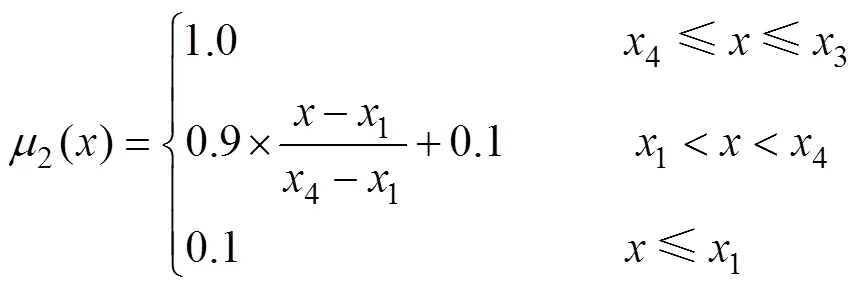
3()=+(3)

式中μ()(=1,2,3)为隶属函数值,1表示指标数值下限,2表示指标最优数值下限,3表示指标最优数值上限,4表示指标数值上限。其中=(1-0.1)/(max–min),=1–max,max表示数值上限,min表示数值下限。为行列矩阵,样本数量,为每个样本秧苗指标的个数。
1.3.2 单项指标权重系数的确定
采用多元线性回归法,根据各指标与其他指标之间的共线性强弱来确定指标权重。




3)通过对每个指标的复相关系数取倒数后归一化得到各项指标的权重系数r,组成权重系数矩阵(式(7))。

1.3.3 综合评价指数
利用模糊矩阵合成计算综合评价矩阵,×T=(式(8))[24-25]。

式中为综合评判矩阵;为单因素指标评价矩阵;为权重系数矩阵。
1.4 壮苗指数的筛选
将番茄11项单项指标采用IBM SPSS Statistics对数据进行归一化处理,对标准化后的指标进行主成分分析,去除各主成分中贡献率小于0.4的成分后,得到对各主成分相关性较大的关键指标。
将每个主成分中相关性较大的指标进行完全随机排列组合,初步建立壮苗指数。以综合评价指数为番茄秧苗的评定标准,以传统壮苗指数为对照,进行壮苗指数与综合评价指数相关性分析[26],筛选出相关性较高且优于传统壮苗指数的壮苗指数。
1.5 壮苗指数的稳定性验证
分别选取60株‘金棚1号’,‘东圣’和‘美颜1319’四叶一心的秧苗,对单项指标进行测定,分别建立3种品种秧苗的综合评价指数,并与筛选出的壮苗指数做相关性分析,以验证其的稳定性。
采用-均值聚类的方法[27-28],以300株番茄秧苗样本的综合评价指数作为类别中心值,对筛选出的壮苗指数进行聚类分析,根据中心值结果确定依据壮苗指数划分的番茄秧苗质量分级标准。
2 结果与分析
2.1 单项指标权重系数
从表1可以看出,番茄秧苗单项指标权重系数整体偏低,在0.070~0.180之间,表明多项指标之间存在明显的共线性。其中株高的权重系数最大为0.180,可能是由于株高和其他指标的相关性较差,而且在番茄秧苗生长过程中差异性较大;茎粗、根冠比(鲜样)、全株鲜质量、根冠比(干样)、全株干质量、叶绿素a、叶绿素b、总叶绿素、类胡萝卜素、SPAD等指标的权重系数均小于0.1,证明这些指标之间关系较为密切,共线性较高。

表1 番茄秧苗单项指标权重系数
2.2 单项指标隶属函数
番茄秧苗单项指标隶属函数参数[19,22-23]如表2所示,其中株高在一定范围可以提高秧苗质量,偏离这一范围都容易导致秧苗素质变差,这种趋势适合于“抛物线型”隶属函数;茎粗、全株鲜质量和全株干质量在一定范围与秧苗质量呈正相关,超过这一范围后对秧苗质量评价影响较小,这一特性符合“正S型”隶属函数;叶绿素a、叶绿素b、总叶绿素、类胡萝卜素、SPAD和根冠比在秧苗质量评价中没有明显的上下限,且均与秧苗质量呈正相关,为“直线型”隶属函数的特点。

表2 番茄秧苗单项指标的隶属函数和临界值
2.3 综合评价指数
由于篇幅有限,在此处仅列出6株样本的综合评价指数计算结果。
1)首先根据四叶一心番茄秧苗的指标测定建立秧苗指标参数矩阵,如式(9)所示。

式中从左至右的列依次为指标株高、茎粗、根冠比(鲜样)、全株鲜质量、根冠比(干样)、全株干质量、叶绿素a、叶绿素b、总叶绿素、类胡萝卜素和SPAD。下同。
2)将番茄秧苗每一列指标带入所属的隶属函数中进行计算,得到番茄秧苗单因素评价矩阵,如式(10)所示。

3)将番茄秧苗单因素评价矩阵与表(1)中指标权质量系数相乘,得到综合评价矩阵,结果如式(11)所示。

将300株番茄秧苗样本的综合评价指数进行汇总(图1),番茄质量综合评价指数在0.26~0.79,曲线的上下范围较大,表明本次试验取样范围较广,包含各种优劣番茄秧苗,能够准确地作为壮苗指数准确性的评判依据。
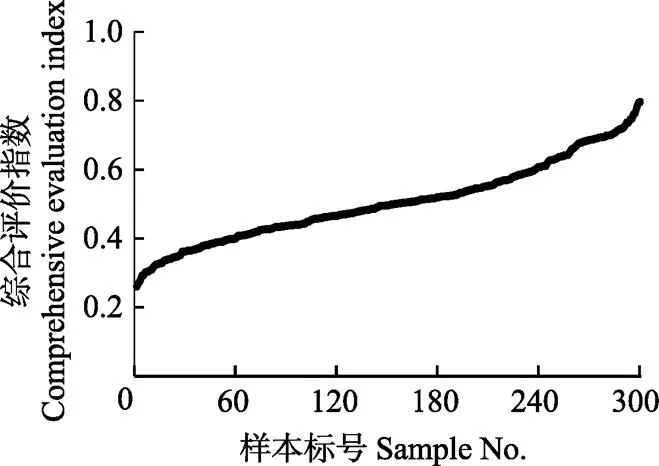
图1 番茄秧苗质量综合评价指数
2.4 单项指标主成分分析
根据11项番茄秧苗单项指标主成分分析结果,前3个主成分总方差的累计贡献率大于80%,可作为番茄秧苗的鉴别指标。从(表3)番茄秧苗主成分旋转后的成分矩阵可以看出,去除掉相关性小于0.4的成分后,番茄秧苗总叶绿素、叶绿素a、类胡萝卜素、叶绿素b、和SPAD等色素指标是主成分1的主要因子,根冠比(干样)、根冠比(鲜样)、全株干质量、全株鲜质量和茎粗等形态指标是主成分2主要因子,株高是主成分3的主要因子。
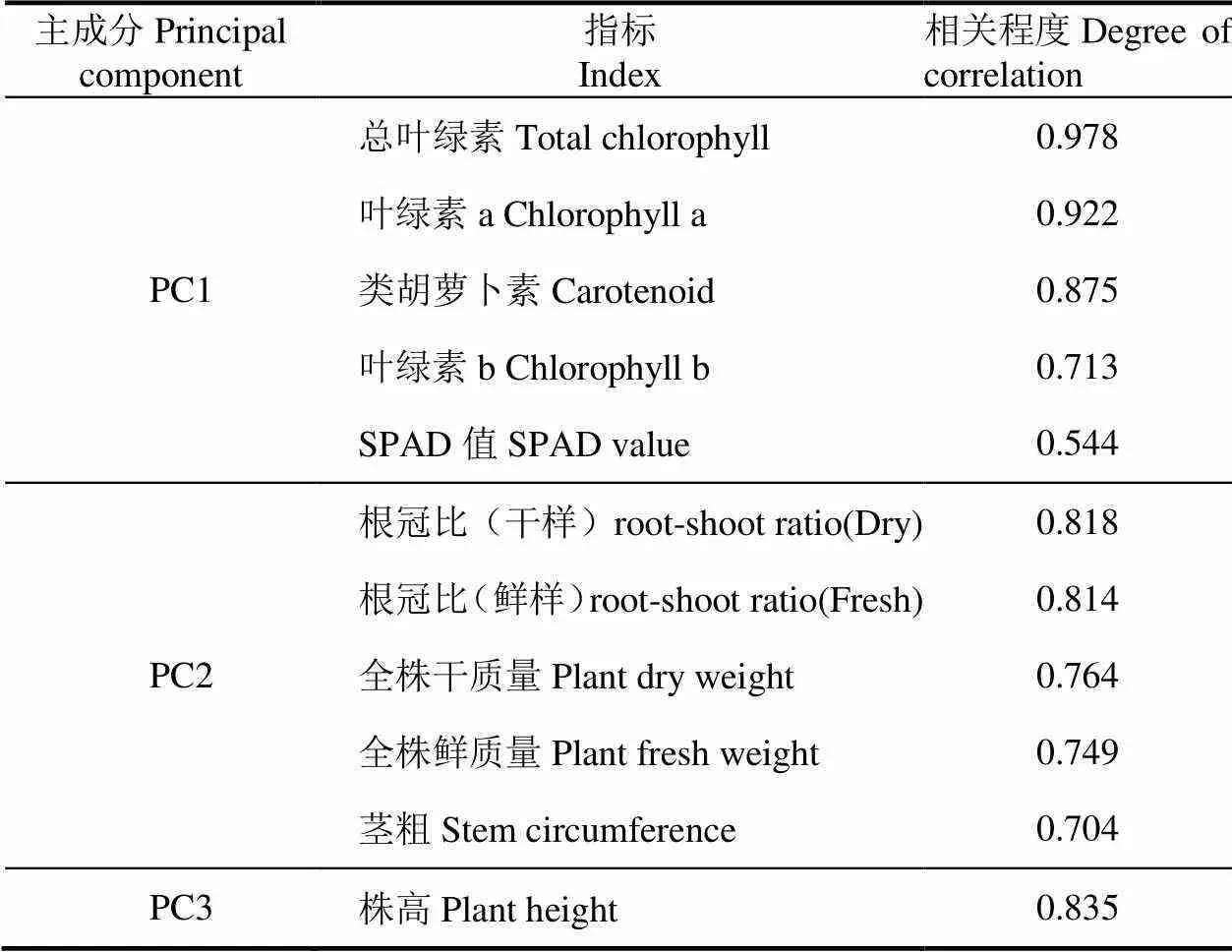
表3 番茄秧苗指标主成分旋转后的成分矩阵
2.5 壮苗指数的初步建立
通过主成分分析,将番茄秧苗的11项单一指标组合为3个主要成分,壮苗指数必须同时包括这3个主成分中一个或多个指标才能全面的体现番茄秧苗质量差异[29-30]。为了使壮苗指数尽量简化且包含全面,在本研究中,从每类主成分中分别选取1项指标进行完全随机排列组合,得到25个壮苗指数(表4),由于株高为抛物线类型(表2),说明株高大于一定数值后对壮苗指数有负向的决定作用,这与张世祥[31]的研究结果一致。为了保障壮苗指数的单调性,壮苗指数的组合中采用“/株高”的方式,其余指标均组合在分子的位置。并以传统壮苗指数公式“(茎粗/株高)×全株干质量”和“(茎粗/株高+根干质量/地上部干质量)×全株干质量”为对照CK1和CK2。
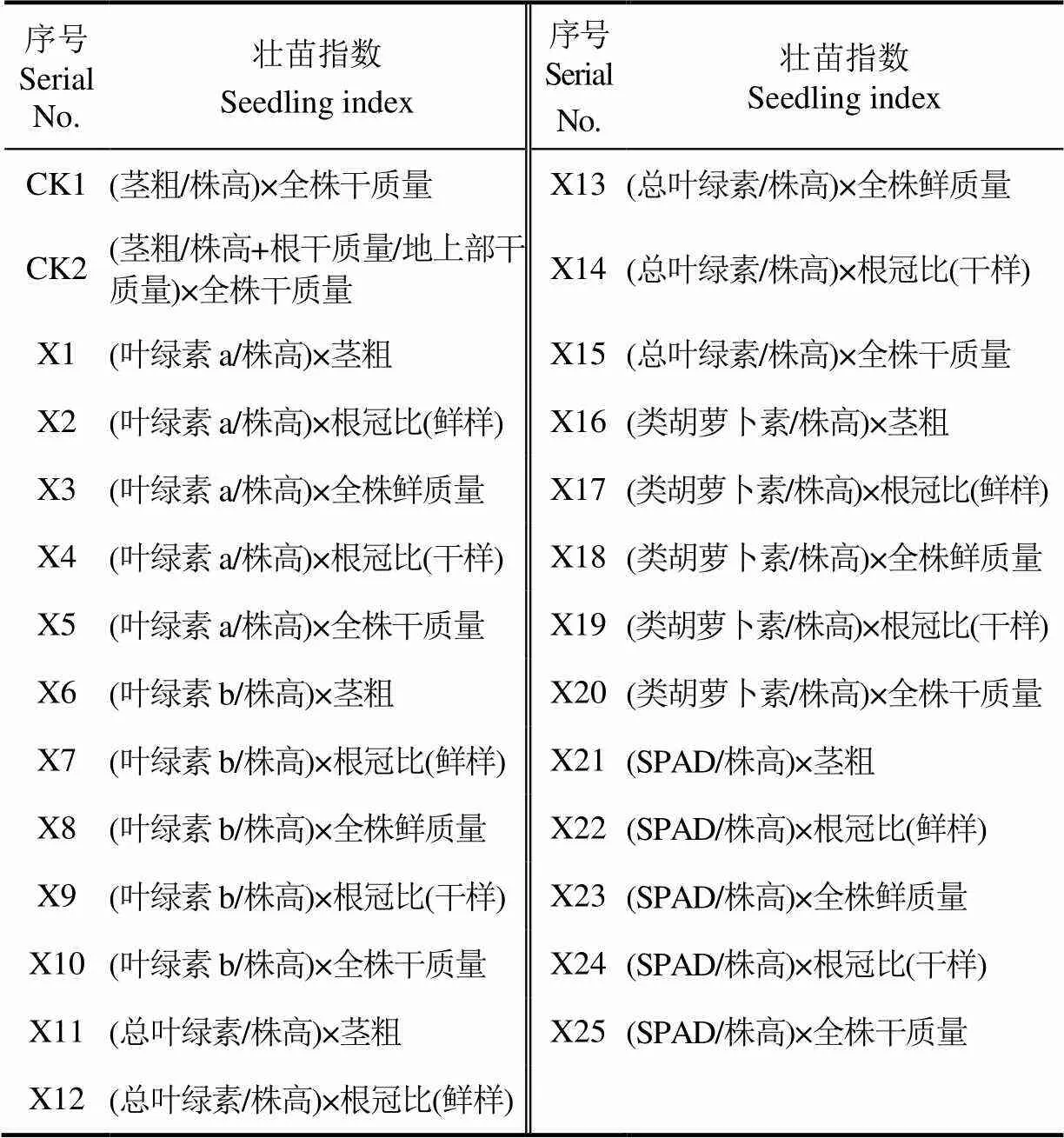
表4 番茄壮苗指数构建
2.6 壮苗指数与综合评价指数相关分析
将得到的壮苗指数与综合评价指数做相关性分析(表5)。所有构建的番茄壮苗指数均与综合评价指数呈极显著相关,CK1“(茎粗/株高)×全株干质量”和CK2“(茎粗/株高+根干质量/地上部干质量)×全株干质量”的相关系数分别为0.723和0.738,其中X15“(总叶绿素/株高)×全株干质量”与综合评价指数相关性最大,达到0.798。筛选得到的4个相关性高于对照的壮苗指数相关性分别为:X5、X15、X20、X25,用于后续评价验证。

表5 番茄幼苗壮苗指数与综合评价指数的相关性分析
注:“**”极显著(<0.01)。下同。
Note: “**”means different significantly at 0.01 level. Same as follows.
2.7 壮苗指数稳定性验证
不同番茄品种秧苗之间壮苗指数相关性存在差异(表6),其中对照CK1、CK2均表现出相关性不稳定(‘金鹏1号’分别为0.627和0.607,‘美颜1319’分别为0.802和0.822),表明CK1、CK2在番茄品种改变时不能全面的评定秧苗质量。在所筛选的壮苗指数中,只有X5“(叶绿素a/株高)×全株干质量”和X15“(总叶绿素/株高)×全株干质量”表现出较高的相关性和较好的稳定性,‘金棚1号’ X5和X15的相关性分别为0.81和0.826;‘东圣’ X5和X15的相关性分别为0.865和0.894;‘美颜1319’ X5和X15的相关性分别为0.883和0.886,且均显著高于对照。综合3种番茄品种的壮苗指数,X5和X15均可作为番茄秧苗壮苗的准确评判,其中X15“(总叶绿素/株高)×全株干质量”最为可靠。
图2为在构建番茄秧苗综合评价指数时所用的300株番茄秧苗样本的壮苗指数X15的分布情况。可以看出所构建出的壮苗指数随着综合评价指数的增加线性增长,相关系数0.797(2=0.635)。可以依据壮苗指数的大小的比较直接判定秧苗质量。

表6 不同品种壮苗指数与综合评价指数的相关性分析

图2 番茄壮苗指数在综合评价指数范围内的分布图
2.8 番茄秧苗质量分类标准
以300株番茄秧苗样本的综合评价指数作为聚类划分依据,将壮苗指数X15进行等级划分。由表7可以看出,番茄秧苗共分为3个等级,其中等级Ⅰ(壮苗指数≥0.065)为优质苗,等级Ⅱ(壮苗指数:0.030~0.065)为合格苗,等级Ⅲ(壮苗指数≤0.030)为弱苗(幼苗或老苗)。在300样本中,Ⅰ、Ⅱ等级苗占65%,Ⅲ等级苗占35%。通过方差分析可以看出,壮苗指数各等级间差异显著,可以作为较好的判别指标[32]。

表7 番茄秧苗质量等级
注:、为方差分析参数。
Note:andare parameters for variance analysis.
3 讨 论
不同果菜类蔬菜秧苗的壮苗指数均不相同,张菊平等[33]以“(茎粗/茎高)×全株干质量”来评价辣椒秧苗;张硕等[34]以“(茎粗/株高+地下干质量/地上干质量)×单株干质量”作为黄瓜的壮苗指数;高玉红等[35]采用“(根鲜质量/地上部鲜质量+茎粗/株高)×全株鲜质量”作为甜瓜的壮苗指数,因此,在壮苗指数使用时需要谨慎选择。论文以番茄秧苗为试材,创建了一种科学的壮苗指数建立的方法,采用模糊综合评判法建立起番茄秧苗的评价体系,求得能全面反映番茄秧苗整体质量的综合评价指数,通过主成分分析对秧苗形态、色素指标进行了筛选和排列组合,并将组合的壮苗指数分别与综合评价指数做相关性分析,筛选出对番茄秧苗质量评价较好的壮苗指数,研究过程中发现,形态、叶片叶绿素含量对于番茄秧苗的质量均存在较大影响,能反映番茄农艺性状指标与生理生化指标的协调关系,充分体现番茄各项指标相互依存、相互制约的生长发育规律。因此,壮苗指数的构建应包含色素指标,这与前人的研究结果是不同的。因此,在实际生产中应以提高物质积累为基础,以防止幼苗徒长为前提,通过壮苗措施,提高叶绿素含量,增加总干质量,来达到培育壮苗的目的。
4 结 论
本研究通过大量番茄秧苗样本的指标测定、各类指标权重的分析以及指标隶属函数类型的分类,构建了覆盖面较大的综合评判指数(0.26~0.79)。并以此为依据筛选出了相关性、稳定性均较好的“(总叶绿素/株高)×全株干质量”作为番茄秧苗的推荐壮苗指数。这一指数包含了株高、全株干质量、总叶绿素等重要指标,且与综合评判指数成线性关系,可以通过壮苗指数数值的大小直观的判定秧苗质量。同时,综合形态和叶片叶绿素指标的壮苗指数充分考虑了秧苗内在和外在的生长状态,可以更加全面的评价番茄秧苗健硕程度。最后,本研究同样依据覆盖面较广的番茄秧苗综合评价指数进一步聚类分级的结果,对所筛选出的壮苗指数进行了分级,将番茄秧苗分为3个等级,其中等级Ⅰ(壮苗指数≥0.065),等级Ⅱ(壮苗指数:0.030~0.065),等级Ⅲ(壮苗指数≤0.030)。此结果可以为实际生产提供较方便的质量评价依据,同时也可以为其他研究者研究番茄秧苗质量提供参考。
[1] 郭孟报,杨明金,刘斌,等. 我国蔬菜育苗产业现状及发展动态[J]. 农机化研究,2015,37(1):250-253.Guo Mengbao, Yang Mingjin, Liu Bin, et al. Present situation and development trend of vegetable seedling industry in China[J]. Research on Agricultural Mechanization, 2015, 37(1): 250-253. (in Chinese with English abstract)
[2] 葛晓光. 果菜壮苗指标研究的概况[J]. 中国蔬菜,1987(1):32-34. Ge Xiaoguang. Overview of research on fruit and vegetable seedling index[J]. Chinese Vegetables, 1987(1): 32-34. (in Chinese with English abstract)
[3] 贾保太,郝素芳,成京辉,等. 平菇菌糠基质在番茄、甜椒育苗上的应用研究[J]. 蔬菜,2018(8):8-10. Jia Baotai, Hao Sufang, Cheng Jinghui, et al. Study on the application ofostreatus substrate in tomato and sweet pepper seedlings[J]. Vegetables, 2018(8): 8-10. (in Chinese with English abstract)
[4] 徐丽荣,葛长军,闫良,等. 不同叶面施肥处理对番茄穴盘育苗的影响[J]. 湖北农业科学,2018,57(14):97-98,104. Xu Lirong, Ge Changjun, Yan Liang, et al. Effects of different foliar application treatments on seedling rearing of tomato seedlings[J]. Hubei Agricultural Sciences, 2018, 57(14): 97-98, 104. (in Chinese with English abstract)
[5] 陆帼一,张和义. 周存田. 番茄壮苗指标的初步研究[J]. 中国蔬菜,1984 (1):13-17. Lu Guoyi, Zhang Heyi, Zhou Cuntian. Preliminary study on the index of tomato seedlings[J]. Chinese Vegetables, 1984(1): 13-17. (in Chinese with English abstract)
[6] 梁志卿,张翼,赵瑞. 浇施不同浓度矮壮素对穴盘苗生长质量及产量的影响[J]. 安徽农业科学,2018,46(22): 41-46,57. Liang Zhiqing, Zhang Yi, Zhao Rui. Effect of different concentration of high-strength on growth quality and yield of acupoint-disc seedlings[J]. Anhui Agricultural Science, 2018, 46(22): 41-46, 57. (in Chinese with English abstract)
[7] Tanaka H, Murai K, Nakanishi T, et al. Storage of plug seedlings of tomato under limited fertilisation, and growth, flowering and yield after planting[J]. Journal of Horticultural Science & Biotechnology, 2018: 1-7.
[8] Liu G, Du Q, Li J. Interactive effects of nitrate-ammonium ratios and temperatures on growth, photosynthesis, and nitrogen metabolism of tomato seedlings[J]. Scientia Horticulturae, 2017, 214: 41-50.
[9] 王正,刘明池,刘海河,等. 不同苗龄期黄瓜水肥需求规律及供液方案的研究[J].中国农学通报,2016,32(4):68-76. Wang Zheng, Liu Mingchi, Liu Haihe, et al. Exploration of nutrient solution demand rule and irrigation schemes in different cucumber seedling stages[J].Chinese Agricultural Science Bulletin, 2016, 32(4): 68-76. (in Chinese with English abstract)
[10] 王举才,席磊,赵晓莉. 基于模糊综合评判的可视化叶色模型数据标准化[J]. 农业工程学报,2011,27(11):155-159. Wang Jucai, Xi Lei, Zhao Xiaoli. Data normalization of leaf color based on fuzzy comprehensive evaluation for visualization model[J]. Transactions of the Chinese Society of Agricultural Engineering (Transactions of the CSAE), 2011, 27(11): 151-159. (in Chinese with English abstract)
[11] 刘全凤,王译萱,齐立学,等. 模糊综合评价法评估盐渍化潮土区温室番茄减量施氮效益[J]. 北方园艺,2018(16):150-154. Liu Quanfeng, Wang Yixuan, Qi Lixue, et al. Evaluation of the effect of reducing nitrogen application in greenhouse tomato in saline-soil area by fuzzy comprehensive evaluation method[J]. Northern Horticulture, 2018(16): 150-154. (in Chinese with English abstract)
[12] 龚雪文,刘浩,刘东鑫,等. 基于模糊算法的温室番茄调亏滴灌制度综合评判[J]. 农业工程学报,2017,33(14):144-151. Gong Xuewen, Liu Hao, Liu Dongxin, et al. Comprehensive evaluation of tomato-deficient drip irrigation system in greenhouse based on Fuzzy algorithm [J]. Transactions of the Chinese Society of Agricultural Engineering (Transactions of the CSAE), 2017, 33(14): 144-151. (in Chinese with English abstract)
[13] 许翩翩,王建柱. 三种常见边坡植物对模拟干旱环境抗旱性能的研究[J]. 草业学报,2018,27(2):36-47. Xu Pianpian, Wang Jianzhu. Drought resistance of three common slope plants determined in asimulated drought experiment[J]. Acta Prataculturae Sinica, 2018, 27(2): 36-47. (in Chinese with English abstract)
[14] Yang W, Xu K, Lian J, et al. Multiple flood vulnerability assessment approach based on fuzzy comprehensive evaluation method and coordinated development degree model[J]. Journal of Environmental Management, 2018, 213: 440-450.
[15] 张敏娟,李昭良,焦锋,等. 8个桑品种的植株茎叶解剖结构及与耐旱性的关联分析[J]. 蚕业科学,2018,44(4): 516-522. Zhang Minjuan, Li Zhaoliang, Jiao Feng, et al. Anatomical structure of the stems and leaves of 8 mulberry cultivars and their relationship with drought tolerance [J]. Sericulture Science, 2018, 44(4): 516-522. (in Chinese with English abstract)
[16] 罗文敏,杨万云,林昌虎. 三穗县何首乌种植基地的土壤质量综合评价[J]. 贵州农业科学,2014(3):182-186. Luo Wenmin, Yang Wanyun, Lin Changhu. Comprehensive assessment of polygonum planting soil quality in sansui county[J]. Guizhou Agricultural Sciences, 2014(3): 182-186. (in Chinese with English abstract)
[17] 李合生. 植物生理生化实验原理和技术[M]. 北京:高等教育出版社,2000:123‒124.
[18] 吴克宁,杨扬,吕巧灵. 模糊综合评判在烟草生态适宜性评价中的应用[J]. 土壤通报,2007(4):631-634. Wu Kening, Yang Yang, Lü Qiaoling. The application of fuzzy comprehensive evaluation in the evaluation of the ecological suitability of tobacco[J]. Soil Bulletin, 2007(4): 631-634. (in Chinese with English abstract)
[19] 葛晓光. 现编蔬菜育苗大全[M]. 北京:中国农业出版社,2004:317-321.
[20] Medasani S, Kim J, Krishnapuram R. An overview of membership function generation techniques for pattern recognition[J]. International Journal of Approximate Reasoning, 1998, 19(3/4): 391-417.
[21] 李家军,杨莉. 对隶属函数确定方法的进一步探讨[J].贵州工业大学学报:自然科学版,2004,33(6):1-4. Li Jiajun,Yang Li. Further study on the determination of menbership function[J]. Journal of Guizhou University of Technology: Natural Science Edition, 2004, 33(6): 1-4. (in Chinese with English abstract)
[22] 白岩,史万华,邢小军,等. 烟草壮苗指数模型研究[J].中国农业科学,2014,47(6):1086-1098. Bai Yan, Shi Wanhua, Xing Xiaojun, et al. Study on the model of tobacco seedling index [J]. China Agricultural Science, 2014, 47(6): 1086-1098. (in Chinese with English abstract)
[23] 申宝营,李毅念,赵三琴,等. 暗期补光对黄瓜幼苗形态调节效果及综合评价[J]. 农业工程学报,2014,30(22):201-208. Shen Baoying, Li Yinian, Zhao Sanqin, et al. Effect of dark period lighting regulation on cucumber seedling morphology and comprehensive evaluation analysis and comprehensive evaluation[J]. Transactions of the Chinese Society of Agricultural Engineering (Transactions of the CSAE), 2014, 30(22): 201-208. (in Chinese with English abstract)
[24] 王洪云,陈爱国,赵国明,等. 云南大理州烤烟生态适宜性评价[J]. 中国农学通报,2012,28(28):280-285.Wang Hongyun, Chen Aiguo, Zhao Guoming, et al. Evaluation of ecological suitability of flue-cured tobacco in Yunnan Dali Prefecture [J]. Chinese Agricultural Science Bulletin, 2012, 28(28): 280-285. (in Chinese with English abstract)
[25] 张久权,张教侠,刘传峰,等. 山东烤烟生态适应性综合评价[J]. 中国烟草科学,2008(5):11-17,71. Zhang Jiuquan, Zhang Jiaoxia, Liu Chuanfeng, et al. Comprehensive evaluation of ecological adaptability of flue-cured tobacco in Shandong[J]. China Tobacco Science, 2008(5): 11-17, 71. (in Chinese with English abstract)
[26] 黄淑华,徐福利,王渭玲,等. 丹参壮苗指数及其模拟模型[J]. 应用生态学报,2012,23(10):2779-2785. Huang Shuhua, Xu Fuli, Wang Weiling, et al. The seedling index of Salvia miltiorrhiza and its simulation model [J]. Journal of Applied Ecology, 2012, 23(10): 2779-2785. (in Chinese with English abstract)
[27] Tsapanos N, Tefas A, Nikolaidis N, et al. Efficient mapreduce kernel k-means for big data clustering[J]. Automatica, 2016, 43(2): 1-5.
[28] Guo L, Abbosh A. Stroke localization and classification using microwave tomography with k-means clustering and support vector machine[J]. Bioelectromagnetics, 2018, 39(4): 312-324.
[29] Moore B C. Principal component analysis in linear systems: Controllability, observability, and model reduction[J]. IEEE Transactions on Automatic Control, 2003, 26(1): 17-32.
[30] Demšar U, Harris P, Brunsdon C, et al. Principal component analysis on spatial data: An overview[J]. Annals of the Association of American Geographers, 2013, 103(1): 106-128.
[31] 张世祥,王海明. 番茄壮苗指数与影响因素通径分析[J].北方园艺,1992(1):17-20. Zhang Shixiang, Wang Haiming. Path analysis of tomato seedling index and influencing factors[J]. Northern Horticulture, 1992(1): 17-20. (in Chinese with English abstract)
[32] 向丽,韩建萍,陈士林. 人工栽培川贝母种苗质量标准研究[J]. 环球中医药,2011,4(2):91-94. Xiang Li, Han Jianping, Chen Shilin. Study on the quality of purposive cultivation ofcirrhosa seedling[J]. Global Traditiongal Chinese Medicine, 2011, 4(2): 91-94. (in Chinese with English abstract)
[33] 张菊平,张兴志. 辣椒壮苗指数与苗期性状的关系分析[J].河南农业大学学报,1999(S1):120-122. Zhang Juping, Zhang Xingzhi. The relationship between the seedling index and seedling traits of capsicum [J]. Journal of Henan Agricultural University, 1999(S1): 120-122. (in Chinese with English abstract)
[34] 张硕,余宏军,蒋卫杰. 发酵玉米芯或甘蔗渣基质的黄瓜育苗效果[J]. 农业工程学报,2015,31(11):236-242. Zhang Shuo, Yu Hongjun, Jiang Weijie. Effect of fermented maize cob or bagasse substrate on cucumber seedling breeding[J]. Transactions of the Chinese Society of Agricultural Engineering (Transactions of the CSAE), 2015, 31(11): 236-242. (in Chinese with English abstract)
[35] 高玉红,闫生辉,邓黎黎. 逆境胁迫对甜瓜幼苗生长的影响及综合抗逆鉴定指标的筛选[J]. 江苏农业科学,2018,46(15):116-118. Gao Yuhong, Yan Shenghui, Deng Lili. Effect of stress on the growth of muskmelon seedlings and selection of comprehensive anti-inverse identification index[J]. Jiangsu Agricultural Science, 2018, 46(15): 116-118. (in Chinese with English abstract)
Selection of tomato seedling index based on comprehensive morphology and leaf chlorophyll content
Gong Binbin1, Wang Ning1, Zhang Tiejun2, Wu Xiaolei1, Lü Guiyun1, Chu Xinpei1, Gao Hongbo1※
(1.071001,2.071001,)
In this study, we aimed to establish an optimal index model of tomato seedlings to improve the accuracy of seedlings evaluation. Based on the determination of eleven individual indicators such as plant height, stem circumference, root-shoot ratio (Fresh), plant fresh weight, root-shoot ratio (Dry), plant dry weight, chlorophyll a, chlorophyll b, total chlorophyll, carotenoid and SPAD of about 300 tomato seedlings with three leaves, according to the seedling standard, the membership function formula of each index was established and the single factor evaluation matrix was calculated. The weight coefficient matrix was calculated according to multiple linear regression. Finally, the fuzzy comprehensive evaluation method was used to multiply the single factor evaluation matrix and the weight coefficient matrix to calculate the comprehensive evaluation matrix and establish a comprehensive evaluation index of tomato seedlings. This index can stably and accurately evaluate tomato seedlings, but the calculation was relatively complicated. Therefore, a simple and effective seedling model was needed instead of the comprehensive evaluation index. Then the principal component analysis was used to screen the indicators and combine them into index model of tomato seedlings. After that, the suitable model was selected through the correlation analysis between the comprehensive evaluation index and seedling index model. Finally, the optimal model was selected based on the verification of suitable model using industrialized nursery seedlings of three different tomato varieties. The results showed that the weight coefficients of each indicator such as plant height, stem circumference, root-shoot ratio (Fresh), plant fresh weight, root-shoot ratio (Dry), plant dry weight, chlorophyll a, chlorophyll b, total chlorophyll, carotenoid and SPAD of tomato seedlings were 0.180, 0.085, 0.098, 0.076, 0.103, 0.078, 0.070, 0.070, 0.070, 0.072, and 0.097, respectively. And the index was divided into three subordinate functions: parabola, positive S and straight line. The parabola included plant height, the positive S included stem circumference, plant fresh weight and plant dry weight, and the straight line included root-shoot ratio (Fresh), root-shoot ratio (Dry), chlorophyll a, chlorophyll b, total chlorophyll, carotenoid and SPAD. The comprehensive evaluation index of tomato seedlings was calculated to be 0.26-0.79, which could comprehensively summarize the overall quality of seedlings as well as objectively and accurately evaluate the robustness degree of seedlings. The eleven individual indicators of seedlings could be divided into three principal components, including morphological indicators, pigment indicators and plant height. The morphological indicators included stem circumference, root-shoot ratio (Fresh), plant fresh weight, root-shoot ratio (Dry) and plant dry weight. The pigment indicators included chlorophyll a, chlorophyll b, total chlorophyll, carotenoid and SPAD. Plant height was divided into one component. Twenty-five seedlings index models were combined using one indicator from each principal component and taking (stem circumference/plant height) × whole plant dry weight and (stem circumference/plant height + root dry weight/dry weight of the ground) × whole plant dry weight as the control group, furthermore, four suitable models such as (chlorophyll a/plant height) × whole plant dry weight, (total chlorophyll / plant height) × whole plant dry weight, (carotenoid/plant height) × whole plant dry weight and (SPAD/plant height) × whole plant dry weight were selected due to the high correlation and representativeness. According to the model verification results of three different tomato varieties, (chlorophyll a / plant height) × whole plant dry weight and (total chlorophyll/plant height) × whole plant dry weight were identified as the optimal models to evaluate the quality of tomato seedlings because of high correlation with the comprehensive evaluation index, good stability and representativeness. This result showed that the fuzzy comprehensive evaluation was good for assessment of tomato seedlings. According to the comprehensive evaluation index and cluster analysis of the selected seedling index model of tomato seedlings, the quality of tomato seedlings was divided into three grades, and the range of seedling index of different grades was given. The research can provide theoretical basis for tomato seedling production and also provide an optimized reference for evaluating quality of other vegetable seedlings.
chlorophyll; morphology; tomato; seedling index; fuzzy comprehensive evaluation; principal component analysis; correlation analysis
2018-10-15
2019-02-12
河北省重点研发计划(农业关键共性技术攻关专项)(18226907D)
宫彬彬,讲师,从事设施工程与无土栽培配套栽培技术研究。Email:yygbb@hebau.edu.cn
高洪波,教授,博士生导师,主要从事设施蔬菜与无土栽培研究。Email:hongbogao@hebau.edu.cn
10.11975/j.issn.1002-6819.2019.08.028
S641.2
A
1002-6819(2019)-08-0237-08
宫彬彬,王 宁,章铁军,吴晓蕾,吕桂云,褚新培,高洪波.综合形态与叶片叶绿素含量的番茄壮苗指数筛选[J]. 农业工程学报,2019,35(8):237-244. doi:10.11975/j.issn.1002-6819.2019.08.028 http://www.tcsae.org
Gong Binbin, Wang Ning, Zhang Tiejun, Wu Xiaolei, Lü Guiyun, Chu Xinpei, Gao Hongbo. Selection of tomato seedling index based on comprehensive morphology and leaf chlorophyll content[J]. Transactions of the Chinese Society of Agricultural Engineering (Transactions of the CSAE), 2019, 35(8): 237-244. (in Chinese with English abstract) doi:10.11975/j.issn.1002-6819.2019.08.028 http://www.tcsae.org
